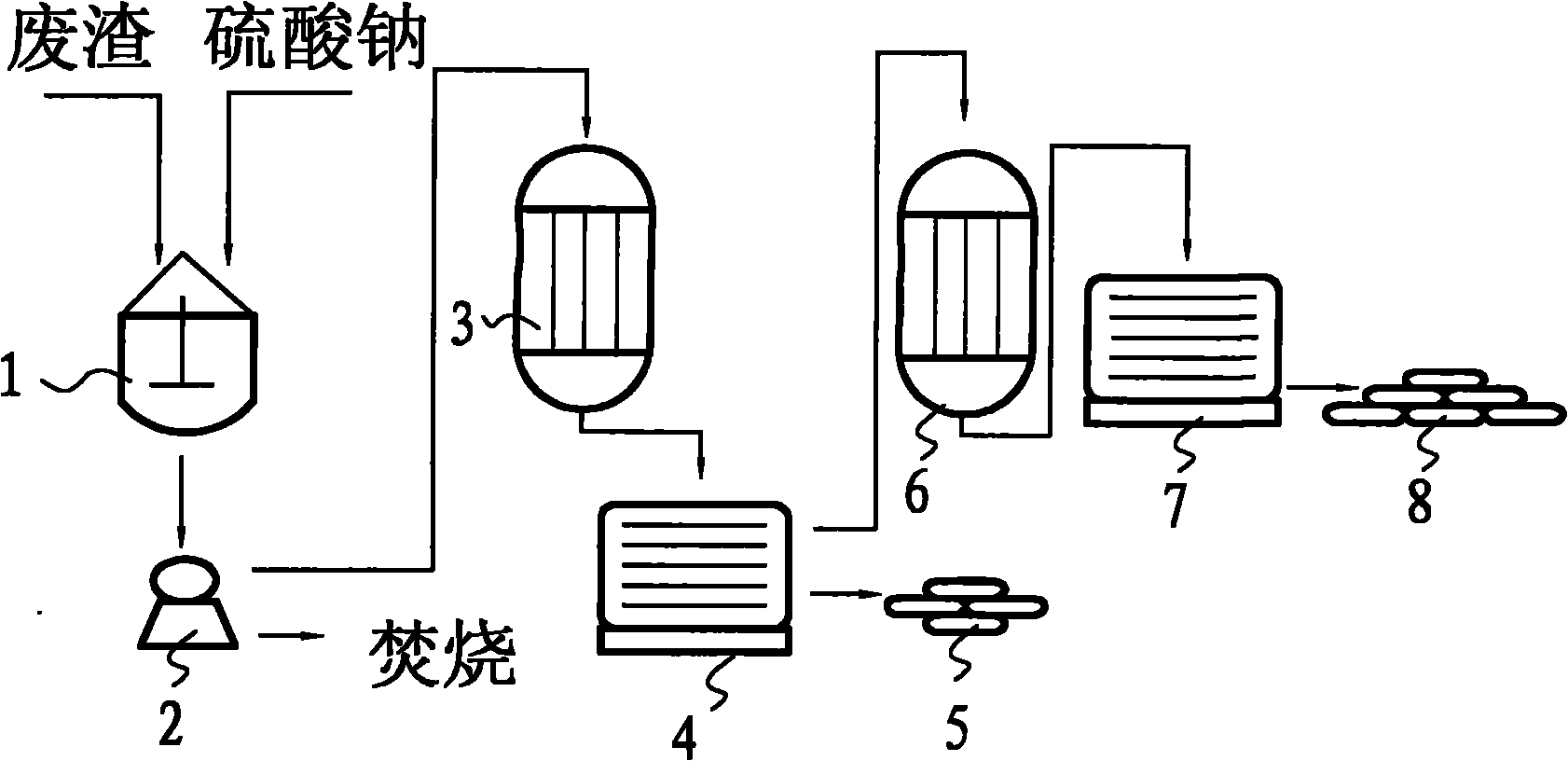Method for preparing sodium cyanide co-production mixed sulfate from waste residues generated by cracking light oil
A technology of light oil cracking and sodium cyanide, applied in the direction of metal cyanide, simple alkali metal cyanide, etc., can solve the problem of not completely eradicating waste residues, and achieve the effect of simple and easy-to-obtain equipment, simple preparation process, and eliminate pollution
- Summary
- Abstract
- Description
- Claims
- Application Information
AI Technical Summary
Problems solved by technology
Method used
Image
Examples
Embodiment 1
[0027] The method for preparing sodium cyanide and co-producing mixed sulfate from light oil cracking waste residue comprises the following preparation steps:
[0028] Step A, put the waste residue obtained in the process of cracking the light oil into the product, put it into the washing tank 1, and use the sodium sulfate solution with a temperature of -10°C and a volume concentration of 5% to stir and wash it three times; each wash is half an hour;
[0029] Step B, filter the mixture after each washing in step A with filter 2;
[0030] Step C, the filter cake obtained by filtering in step B is sent to incineration;
[0031] Step D, the filtrate obtained by filtering three times in step B is sent together to carry out low-temperature distillation in the vacuum distiller-3, and the distillation temperature is 40° C.;
[0032] Step E, cooling the liquid distilled in step D through cooler-4 to obtain sodium cyanide crystal 5;
[0033] Step F, sending the remaining liquid in th...
Embodiment 2
[0035] The method for preparing sodium cyanide and co-producing mixed sulfate from light oil cracking waste residue comprises the following preparation steps:
[0036] Step A, put the waste residue obtained in the process of cracking the light oil into the product, put it into the washing tank 1, and use the sodium sulfate solution with a temperature of 0° C. and a volume concentration of 6% to stir and wash it three times; wash for half an hour each time;
[0037] Step B, filter the mixture after each washing in step A with filter 2;
[0038] Step C, the filter cake obtained by filtering in step B is sent to incineration;
[0039] Step D, the filtrate obtained by filtering three times in step B is sent together to carry out low-temperature distillation in vacuum distiller-3, and the distillation temperature is 45° C.;
[0040] Step E, cooling the liquid distilled in step D through cooler-4 to obtain sodium cyanide crystal 5;
[0041] Step F, sending the remaining liquid in ...
Embodiment 3
[0043] The method for preparing sodium cyanide and co-producing mixed sulfate from light oil cracking waste residue comprises the following preparation steps:
[0044] Step A, put the waste residue obtained in the process of cracking the light oil into the product, put it into the washing tank 1, and wash it three times with a sodium sulfate solution with a temperature of 5° C. and a volume concentration of 6%; each time for half an hour;
[0045] Step B, filter the mixture after each washing in step A with filter 2;
[0046] Step C, the filter cake obtained by filtering in step B is sent to incineration;
[0047] Step D, the filtrate obtained by filtering three times in step B is sent together to carry out low-temperature distillation in vacuum distiller-3, and the distillation temperature is 50° C.;
[0048] Step E, cooling the liquid distilled in step D through cooler-4 to obtain sodium cyanide crystal 5;
[0049] Step F, send the remaining liquid in the step E to the vac...
PUM
 Login to View More
Login to View More Abstract
Description
Claims
Application Information
 Login to View More
Login to View More - R&D
- Intellectual Property
- Life Sciences
- Materials
- Tech Scout
- Unparalleled Data Quality
- Higher Quality Content
- 60% Fewer Hallucinations
Browse by: Latest US Patents, China's latest patents, Technical Efficacy Thesaurus, Application Domain, Technology Topic, Popular Technical Reports.
© 2025 PatSnap. All rights reserved.Legal|Privacy policy|Modern Slavery Act Transparency Statement|Sitemap|About US| Contact US: help@patsnap.com


